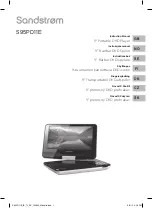
I.S. 18 / 21 / 24 / 27 50
Hz
- 12
GB
GB
4.4 Exhaust system
The combustion gas/water exhaust system of the
generator must be independent of that of the main
engines.
The pipe length from the highest point of the exhaust pipe
to the exhaust must not exceed 2 m. This is to prevent
that when the generator is switched off the water left in
the exhaust pipe flows back to the engine after the
exhaust has been filled.
1
- Exhaust
Dampens the exhaust noise and prevents water
backflow to the engine. It is recommended to install
the exhaust not more than 1 m from the generator
and to position it at a height as shown in Figures
4,5,6,7.
2
- Silencer
Further reduces the noise. It is recommended to
install the exhaust not more than 1 m from the sea
exhaust union.
3
- Sea exhaust union
It must be installed in such a position as to always
be above sea level in all boating conditions.
5 FUEL CIRCUIT
The generator is diesel-powered through the unions
marked
fuel inlet
(Fig.12 Ref.2) and
fuel outlet
(Fig.12 Ref.3); the latter is for the return of excess fuel.
No filter elements are required in the fuel tank connection
since a fuel filter is already fitted on the generator; it is
however good practice to fit a cock on the feed line
downstream of the tank as well as a non-return valve in
order to prevent the fuel system from emptying out for
any reason. Use a valve with 50 millibar opening (max.
head 0.8 M).
The fuel pipes must be made of rubber resistant to
hydrocarbons with an inside diameter of 8 mm.
For further information, read the use and maintenance
handbook of the engine manufacturer.
6 ELECTRICAL CONNECTIONS
6.1 Battery connection
To start the generator a stand-alone 12V battery is
required with a capacity of 100 Ah.
Do not use a battery with a capacity lower than that
indicated.
It is connected to the generator terminals (Fig.12 Ref.4)
with cables of 25 mm2 cross-section for distances up to
5 m, and 35 mm2 cross-section for greater distances,
in the following order:
- First connect the positive pole (
+
) of the battery to the
terminal marked with the symbol (
+
) on the generator.
- Then connect the negative pole (
-
) of the battery to the
terminal marked with the symbol (
-
) on the generator.
- Spread specific mineral grease on the connections to
reduce oxidation or corrosion.
The generator is equipped with an electronic device for
automatic charging of the starter battery, which can
deliver 40 A at 12V at full power.
Install the battery in a ventilated housing separate from
the generator and any device which may produce heat or
sparks. Periodically check the state of the terminal
connections and the battery water level. If the cables
need to be disconnected, work in reverse order from
connection. Do not invert the polarities of the connection
cables; the generator and the battery may be seriously
damaged.
Do not connect any other loads to the battery.
In order to minimise galvanic currents, the (-) of the
generator battery must not be connected to the (-) of
other batteries on board.
6.2 Remote control panel connection
There are two remote control panels available, installable
on the bridge, which can be connected to the generator
for starting and stopping.
Both models are supplied with a 20 m electric connection
cable with a connector fitted at the end.
Fit the connector of the connection cable to the special
coupling located at the lower part of the instrument panel
casing inside the generator (fig.15 ref.1) and the opposite
part to the remote control panel.
6.3 AC connection
This connection can be made directly on the
magnetothermal switch of the machine located on the
generator panel (Fig. 14 Ref.1). The magnetothermal
switch can be accessed after removing the closing panel
as shown in Fig.13 Ref. 1.
- Ensure that the sum of the loads to be fed does not
exceed the rated output of the generator.


































